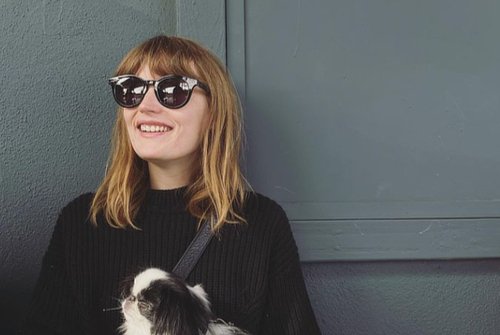
Meg Dougherty
Who are you, and what do you do?
Hellooooooo. I'm Meg Dougherty and I'm a concert lighting and production designer. I work with bands / musicians (usually just referred to as "artists") to develop all visual elements of their tour and create an aesthetic specific to their style and tastes. This usually involves designing the lighting, the set, video walls, projection and so on.
For me the foundation of the design is usually based on album artwork and the overall narrative of their album and what the artist wants their audience to feel during the show. There can sometimes be a lot of back and forth with the design or sometimes the artist will approve the first thing you submit. I prefer to present the design concepts via a deck with 3D rendered images of the stage to help the artist visualize things easily. This is sometimes presented on a [Zoom][zoom.2] call but sometimes due to time constraints I send over the deck plus some text explaining my thought process on why I chose the elements I did and why I think it would work for their show.
Once the overall design concept is approved it gets down to usually the most time intensive process which is programming the actual show. The programming side is basically telling a bunch of robots (moving lights) exactly what to do and when, what color, what position, how bright, etc down to a quarter of a second... and that level of accuracy carries on throughout the entire 60-90 min or more show. Basically all the staging elements are programmed to animate in time with the music. The same idea applies to the other staging elements like video walls.
This programming is typically first done in "previz" which is basically a 3D model of the stage design, so you get a sense of what it's going to look like once it's set up in person. Since programming is so time intensive, it's now normal to spend at least a week in previz getting the foundation of the cueing set up and what's going to happen with lighting and video throughout the entire show, and then take that rough draft into production rehearsals where you finally see the design in real life for the first time. Then I usually spend at least a week in production rehearsals, making modifications to what we did in previz, as previz is not entirely accurate of course so things change once you see it in person. Previz is still an important step though as it's typically a good foundation that just needs small adjustments.
Once rehearsals are over, I go to the first show, make sure everything is understood and works well for the hand off to the people who take the design out for thee rest of the tour. Some designers (although they are becoming far less common now) will do the entire tour with their design. Personally, touring is not for me anymore after living that lifestyle for the last 10 years so I'm happy to hand it off to trusted individuals to maintain the integrity of the show for the entire run.
What hardware(tools) and software do you use?
I have a 6 year old Samsung touch screen laptop that sometimes will allow me to run the software I need to use after I wait for it to boot up for about 10-15 minutes. It's currently being replaced by a Razer laptop with a [1080 Ti graphics card][geforce-gtx-1080-ti] with an i9 processor but they're currently all on backorder so I'm just patiently waiting.
For the programming side, the industry standard is on a console called [grandMA2][] (soon to be [grandMA3][] which has just been released). It's a pain in the ass to learn this console but once you get the hang of it, it's a very powerful tool.
In the initial design stage I use Vectorworks (VW) which is CAD / BIM software primarily for architecture and landscaping. VW has something called [Spotlight][spotlight.2] which is specific to entertainment drafting. I use VW to try out ideas and make sure it's to an appropriate scale. These drawings also help to ensure the design is set up correctly every day. Using VW definitely beats my previous method of drawing lighting fixtures on a napkin and hoping everything fits on stage.
For the 3D rendering portion, I use a software called [Depence2][]. This software was created more for rendering and programming water fountains (which tbh sounds like a sweet gig) but they've also developed it for stage design rendering and "previz" as well.
What would be your dream/dream setup?
Currently I'm working out of a 100 sq ft office / room in my house that I share with my now fiance. It's a bit tight and awkward when we have Zoom meetings or calls, or I'm programming a show with audio and he's trying to focus on something else.
Due to this lack of space we're looking to move soon, so in a dream scenario, we get a place with a pool house, and convert that into 2 office areas (one for each of us) plus a previz space for programming the actual show that we can also rent out to other designers when we're not using it for our own shows. This involves buying a bunch of gear (an MA3 console, render computers, monitors etc) but I think it's a smart investment.
When it comes to work spaces I'm pretty sensitive to the aesthetics of it otherwise it's hard to focus or be creative. The space has to feel uncluttered, open and bright. A view into some sort of nature / plant situation also helps.
And obviously my dream setup also includes a spot for my dog Rupert to sun bathe in as well.
NerdyBio is a community initiative by StatusNeo to capture the work life of interesting professionals and icons from various walks of life!!!
Want to get featured? Propose us here